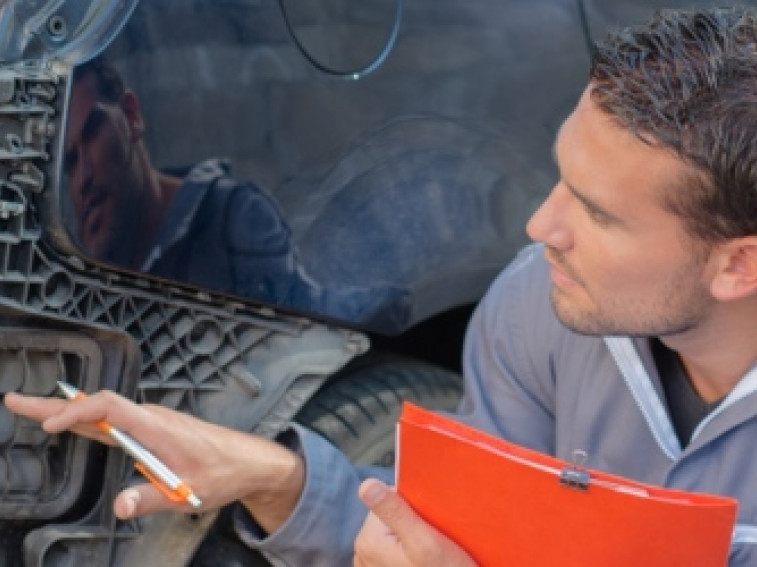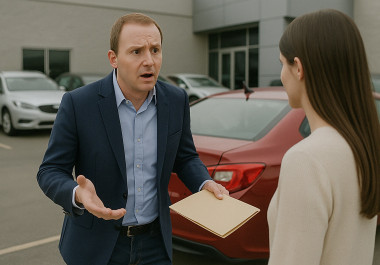Category N cars are just one of several types of used, seized and salvage vehicles that we stock in our online car auctions right here at RAW2K, from manufacturers ranging from Citroen to Audi. These vehicles can be found in a wide range of conditions, and their exact state is roughly indicated by their relevant salvage category.
One of the possible salvage categories is known as Cat N, a highly variable category which can denote anything from a vehicle that’s suffered a serious mechanical fault, to one with only negligible cosmetic damage. Over the years, we’ve fielded lots of questions from our customers about Category N vehicles, so we’ve addressed some of the most common below. Let’s start with the basics!
What is a Category N car?
Essentially, a Category N write-off is a salvage car which the insurance company deems unworthy of repair due to non-structural damage. This happens when the cost of the necessary repairs would exceed the car’s total value, so the insurer will judge them to be uneconomical and write-off the car instead.
ategory N is one of four ‘salvage titles’ that can be assigned to salvage cars by the Association of British Insurers. They’re there to serve as a rough indicator of the level of damage at a glance. The four main categories are:
Category A - scrap only. The car cannot be resold and can never be put back on the roads. Category B - the car has sustained significant damage and must be scrapped. However, parts can be removed from it for reuse or resale. Category S - notable structural damage, but the car can be theoretically repaired (despite being uneconomical to do so). Category N - non-structural damage, but the car can be theoretically repaired (despite being uneconomical to do so).
Category N and Category S used to known as Category D and Category C, respectively, but they were reclassified in October of 2017. There are still many salvage car dealers and car auction sites which refer to them by their former monikers - so it’s helpful to bear the name changes in mind!
What does Cat N mean?
The N in Cat N stands for ‘non-structural’, which means that the damage it sustained hasn’t affected its underlying structural frame or chassis. The nature of this non-structural damage can vary widely, which is partially why individual Category N cars can sometimes differ so much in value.
Cat N damage might be simply cosmetic, such as the bodywork or bumpers, or it could be small but important parts such as the headlamps or mirrors. However, sometimes vital parts such as the steering column, brakes or electrics could be the ones suffering from damage, making them expensive but crucial repairs if the car is ever to become roadworthy again.
Often, Cat N cars are accident-damaged cars which have been involved in collisions at significant speed. Sometimes, however, a relatively minor bump is all it takes to nudge a low-value car over its damage threshold, making it uneconomical to repair.
Are Cat N and Cat D cars the same?
Yes. A big part of the reason why Category D was renamed Category N in 2017 was so that it would be clearer both to professionals and laymen what the salvage title meant: N is for non-structural. Simple.
Can you drive a Cat N car?
Yes, but only as long as it’s been judged to be roadworthy by a qualified professional. A Category N salvage title doesn’t mean the car is necessarily unsafe (although some of them certainly are). Mostly, it’s simply there to indicate that the car is uneconomical to repair.
Since Cat N cars don’t have damage to their underlying structural frame, it’s not uncommon to find they’re often a bit beaten up, but perfectly safe to drive. Obviously though, it’s important not to take this on faith, especially if the car has previously been involved in an accident.
If you’ve got an existing car that’s been assigned a Cat N salvage title, you’ll often be given the choice between having it written off, or classed as salvage retention. If you choose the latter option, this will then enable you to have it repaired and continue driving it.
Since you’re the one bearing the cost in these cases, the economics become largely irrelevant to the insurer, so many will be quite content to give you the option. Bear in mind, though, that it’s likely to affect your premiums if you decide to ever switch insurers.
Should I buy a Category N car?
That’s up to you! As with many of these sorts of decisions, it’s often a risk/reward calculation. Category N cars are typically a lot cheaper to buy than brand new versions of the same vehicle, but you’ll need to work out what costs will be involved in making sure it’s suitable for your intended purposes - whether that’s driving it or ultimately selling it on.
If you’re planning on making it roadworthy again, it’s wise to get as much information as you possibly can about the type and scale of damage to the car, as well as any other repairs it might have undergone. It’s also a good idea to have it examined by another qualified professional, who can pick up on anything important.
Of course, one of the most beautiful and frustrating things about buying auction cars is that much of the value is subjective. While insurers make their judgements about what’s economical based on cold hard sums, drivers and owners tend to be a little more emotional, and personal preference or sentiment can affect how much they’re willing to spend on a car.

If you’ve got your heart set on buying a Category N car for personal use, for example, you may well be willing to spend whatever it takes to get it roadworthy. If you’re buying it to sell on, however, you’ll have to weigh up the likely profit margin well in advance, to ensure you’re not breaking even - or worse, losing money.
Don’t forget, one of the quirks about Category N cars is that this salvage category can be given to vehicles even with relatively light damage. A old, heavily depreciated car might which sustains cosmetic damage in a minor fender-bender can then sometimes be written off, despite the fact that the car is otherwise be in good condition. All simply because the repairs will be worth more than its value.
With that in mind, it’s certainly taking a close look at any Category N car you come across in online vehicle auctions, whatever you ultimately plan to use it for. It could be more of a bargain than you first thought!
Can you insure a Cat N car?
Yes, although you might find that Cat N insurance is often more expensive, especially if you switch insurers. Because Category N cars have previously been written off, they pose more of a risk to your insurer, who are consequently more likely to charge higher premiums to cover one.
However, this scenario isn’t necessarily a given. Some insurers will even offer specific types of cover for Category N cars, whereas others won’t insure them at all. There aren’t really any hard and fast answers, besides that age-old adage - it pays to shop around. Getting an engineer’s report can make life easier, if you’re able to secure one.
If you’ve got any further questions, we’ve previously published an extensive guide to Category N insurance right here on our site, so you can check that post out for more detailed information.
Does a Cat N car need a new MOT?
Not necessarily. After all, something as simple as a minor dent in the bodywork can theoretically cause a car to become Category N, even though the vehicle as a whole remains perfectly safe and driveable. Plus, scratches and minor forms of cosmetic damage aren’t accounted for by an MOT, so it can potentially be a waste of time and money to retake one.
However, various insurers might insist on an MOT for their own purposes, as it’s one potential way they might like to be reassured of the car’s roadworthiness. If you’re buying a new Category N car which you intend to drive yourself, you may well need a new MOT if its existing one has expired.
Meanwhile, if you own a car that’s just written off as a Category N but you’ve chosen to have it classed as salvage retention, then it’s never a bad idea to bring your next MOT forward by a few months, just so that you and your insurer have that extra peace of mind.
When you’re browsing the listings for our own auction cars here at RAW2K, you’ll sometimes be able to clearly whether or not the vehicle’s MOT has expired, or - if applicable - the date when it does.

How to remove cat N from a car
In short, you can’t. According to the AA, once a vehicle has been officially classified as a Category N car, then that remains part of its history for life, and will always show up in future history checks. While this obviously isn’t great news if you’re trying to sell a Category N car - as it normally affects its resale value - it does make sense from a buyer’s perspective. Buyers should be (and are) entitled to know when they’re buying a used car that’s previously been written off, even that damage has been competently, comprehensively repaired.
Since these are Category N cars we’re talking about, in some cases that classification might have very little bearing on their decision - such as cases concerning cars that have only cosmetic damage to their bodywork or wing mirrors. On the other hand, more serious damage (like electrical or mechanical failure) might make all the difference as to whether or not they buy the car. Whatever the outcome of their decision, the important thing is that at the end of the day it’s their choice to make. The industry’s responsibility is to enable buyers find out all the details of any write-offs for themselves if they want to, so they can make an informed decision based on their own best interests. And that’s why you can’t remove Category N from a car!
Are Category N cars safe?
That very much depends on the specifics of each individual vehicle, but on the whole, Category N cars are one of the safest types of salvage car to drive. They tend to be safer than Category S cars, since the latter have suffered severe structural damage that often makes them (by definition) riskier to drive, and more expensive to repair. Category N cars are certainly a lot safer than Category A or Category B cars - all cars in these latter two categories have been so badly damaged that it’s illegal to ever put them back on the roads.
Technically, a Category N car doesn’t have to be particularly badly damaged to be written off. It just needs to be deemed more expensive than it’s worth to repair. This means you can have Category N cars that have only suffered minor cosmetic damage, but if they’re deemed to be low-value vehicles then this can easily be enough to push them into the Category N salvage title. As a result, a significant proportion of Category N cars are perfectly safe to drive - one of the many reasons they’re such popular salvage cars to buy!
Does a Category N car need a VIC check?
No. The Vehicle Identity Check (VIC) scheme was abolished in late 2015, following a review by the Department for Transport.
The scheme was originally introduced back in 2003, primarily as a way of reducing car ‘ringing’. A car ‘ringer’ was one that had been stolen but passed off as accident or damage-repaired, often being sold on to innocent buyers before anyone realised what had happened. The scheme attempted to tackle this by placing a marker on each written-off vehicle against DVLA records, which meant it wouldn’t get another logbook issued for it until it had been subject to a VIC check.
While the effectiveness of the scheme was disputed, advancements in registering and tracing technology meant that the practice of ‘ringing’ started to result in a gradual decline in vehicle ringing regardless, and so the DfT wrapped up the VIC scheme in 2015.
How much value does a Category N car lose?
Even if a Cat N car has been repaired competently and to a flawless standard, it will likely see somewhere between a 20% and 40% decrease in sale value, compared to a similar model of the same age, condition and mileage. Some sellers find that it’s actually easier in many cases to sell a Category N car that’s in need of repair rather than try and fix it up themselves, as buyers with the right expertise and equipment will happily take it as-is so that they can make their own savings by doing the repairs themselves.

Is it possible to buy back a Category N car from my insurer?
If your insurer declares your Category N car to be a write-off, the standard procedure is for them to pay you compensation, in accordance to its pre-accident value. If you’d like, you can refuse this and buy the car back from them. If you choose to go down this route, you’ll be responsible for getting the car back into a roadworthy condition. In some cases, this might involve extensive mechanical work, whereas in others, it might be simply a case of repairing a bit of cosmetic damage. Really, it depends on the circumstances in which the car was written off!
It helps that Category N cars and Category S are the only vehicles which can be legally sold back to owners. Any that have been classed as Category A and Category B must be scrapped, as they have been deemed to be permanently unroadworthy.
What’s the best way to sell on a Category N car?
Well, right here at RAW2K of course! And by the same token, it’s the best place to buy a Cat N car, too. We’ve got a huge range of Category N cars in our online car auctions for used, seized and salvage cars, so whether you’re looking for your next personal vehicle, or you’re looking for something to fix up and sell on, we’re sure to have what you’re looking for. Why not take a look around, and see what you can find?
We’ve got a huge range of Category N cars in our online car auctions for used, seized and salvage cars, so whether you’re looking for your next personal vehicle, or you’re looking for something to fix up and sell on, we’re sure to have what you’re looking for. Why not take a look around, and see what you can find?




